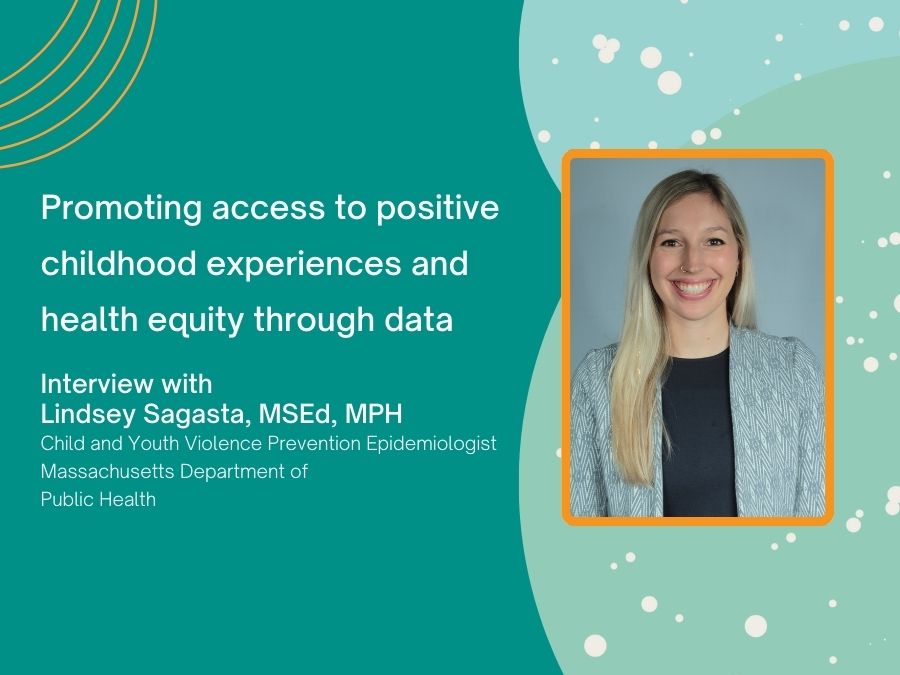
Key takeaways
- This interview features Lindsey Sagasta, a child and youth violence prevention epidemiologist within the Bureau of Community Health and Prevention and Office of Statistics and Evaluation at the Massachusetts Department of Public Health.
- The Positive and Adverse Childhood Experiences (PCEs & ACEs) Data dashboard was built to strengthen surveillance of Positive Childhood Experiences (PCEs) and Adverse Childhood Experiences (ACEs) in Massachusetts and turn the data into action for healthier communities.
- The dashboard is designed for anyone to use data to drive equitable change in childhood well-being. It currently draws on Massachusetts Youth Risk Behavior and Youth Health Surveys, which represent public school students but exclude private, residential, hospitalized, or justice-involved youth, and includes a user guide to help interpret data responsibly.
- PCEs promote healthy development, buffer the effects of ACEs, and can prevent them from occurring. Using the Four Building Blocks of HOPE helped Sagasta’s team select and highlight PCE data through a strength-based lens, showing where positive experiences can be expanded to improve health and resilience across all groups.
This interview summary was created with the assistance of artificial intelligence (AI) and reviewed by the HOPE National Resource Center staff before publication. No other parts of the blog post were generated by AI. Found an error? Let us know.
Lindsey Sagasta, MSEd, MPH on collecting PCEs and ACEs data to inform policy
The HOPE National Resource Center partnered with the Massachusetts Department of Public Health (DPH) and a multi-sector committee to help create a positive and adverse childhood experiences (PCEs & ACEs) data dashboard. The data present a picture of childhood experiences in the state of Massachusetts and can help inform actions and policy decisions aimed at improving the health and well-being of children in Massachusetts. Lindsey Sagasta, MSEd, MPH, Child and Youth Violence Prevention Epidemiologist at DPH, led the creation of the dashboard.
This blog features an interview with Sagasta Read on how this project supports health equity, promotes positive childhood experiences, and integrates the HOPE framework and the Four Building Blocks of HOPE.
Tell us about the PCEs and ACEs data dashboard your team created, the goals for this dashboard, and how it helps promote health equity.
The first goals of this dashboard are to build surveillance infrastructure for PCEs and ACEs data and to support data-to-action activities related to these topics throughout the Commonwealth. Data-to-action refers to using information (like numbers, percents, or lived experiences told by individuals) to help plan activities that can positively change health in our communities. Further, this dashboard aims to help users understand specific experiences that can impact health and opportunity in childhood by type of experience and population group identities. Sharing and publicizing these data supports users’ work to promote and prioritize PCEs as well as to identify ways to prevent ACEs and increase healthy outcomes for all Massachusetts residents. For example, sharing that opportunities to develop positive adult-youth relationships outside of the home strengthens children’s healthy development, and knowing that particular youth are not as likely to report these relationships, may encourage youth organizations to provide mentorship opportunities that are tailored to their community.
Although safe, stable, and nurturing relationships and environments (PCEs) and trauma and sources of toxic stress (ACEs) can be present in everyone’s lives, many roadblocks in our system have created significant barriers to supports for many groups of people. This is evident in the data we can explore in the dashboard. These barriers are not representative of individual choices but rather the way the system is set up — they are the result of a long history of structural racism and other forms of oppression. For this reason, to promote racial and health equity, the dashboard frames childhood experiences in light of the social determinants of health (SDoH) and environmental factors that can impact who experiences what. On the dashboard web page and within the user guide available for download, we provide racial justice framing to help users interpret the data with a racial and health equity lens.
However, it is important to remember that, while people’s lives tell the entire story, the data presented in this dashboard only show us a part of these experiences. Because of that, the data shouldn’t be used alone in making decisions.
Why was it important to include Healthy Outcomes from Positive Experiences (HOPE) and other PCEs in the data dashboard?
PCEs have been shown to increase the likelihood of positive childhood and adult health outcomes and can reduce the impact of ACEs and/or help to prevent ACEs from occurring.
We worked with Tufts Medical Center’s HOPE researchers to think about PCEs to include in this dashboard. They use the Four Building Blocks of HOPE framework to support thinking about experiences that promote positive relationships, positive engagement, positive environments, and opportunities for social-emotional development. The DPH surveillance subcommittee and dashboard development team used the building blocks to review selected data sources for questions that identify PCEs. The framework helped us prioritize highlighting PCEs over ACEs in leading with a strength-based lens and the science of the positive.
When you view PCEs in the dashboard, higher percentages of the specific PCE are desirable. The more residents have PCEs, the more residents can thrive, reduce the exposure to or impact of ACEs, grow into healthy adults, and respond to adversity in the future. Seeing disparities in PCEs for particular groups of residents within a population identifies opportunities to promote specific PCEs for those groups, including through community investments and addressing systemic barriers.
Is there anything else you would like to share?
The dashboard is meant to be used by anyone in the public interested in childhood experiences. That means parents and caregivers, youth, community members, community organization employees, community advocates, local board of health staff, state government staff, etc. The purpose of the dashboard is for anyone to be able use these data to create action to make a change. This change can include impacting policies, practices, and systems that enable equitable positive childhood experiences.
Currently, the dashboard contains data from the Massachusetts Youth Risk Behavior Survey and the Massachusetts Youth Health Survey. These surveys are representative of the students that are physically in Commonwealth public schools on any given day. Kids who are in private schools, absent for any reason, or in residential programs or special education schools, hospitalized, or in Department of Youth Services custody are not included. For more information about the methodology of these surveys and the limitations associated with them, please review the dashboard user guide.
More about Lindsey’s role at DPH:
Lindsey Sagasta is the Child and Youth Violence Prevention (CYVP) Epidemiologist within the Bureau of Community Health and Prevention and Office of Statistics and Evaluation at DPH. As a CYVP Epidemiologist, she focuses on child and youth violence prevention, including gun violence prevention, promoting PCEs, and preventing ACEs in the Commonwealth of Massachusetts.
Additionally, she supports surveillance and evaluation data needs for the CYVP Unit at DPH. This unit funds community-based initiatives across the state working to prevent youth violence. These initiatives include educating about and implementing interventions that prevent and/or address the overlapping root causes of all forms of violence (risk factors) and promoting factors that increase the resilience (protective factors) of youth who are 10-24 years old.
Lindsey also serves as the lead epidemiologist for the Essentials for Childhood Preventing Adverse Childhood Experiences through Data to Action (EfC-PACE:D2A) federal grant. This grant supports efforts to:
- Build and improve ACEs and PCEs data collection infrastructure and capacity
- Implement and sustain ACEs prevention strategies, focusing on health equity
- Conduct ongoing data-to-action activities to inform changes to the implementation of preventions strategies.
Lindsey received a bachelor’s degree in biology and environmental studies from Colgate University, a master’s degree in urban early childhood special education from Canisius College, and a Master of Public Health degree in epidemiology and biostatistics from Boston University School of Public Health.
Note: The dashboard was developed with funding from the CDC Preventing Adverse Childhood Experiences through Data to Action (PACE:D2A) grant and continued development is supported with grant funding from the new CDC Essentials for Childhood Preventing Adverse Childhood Experiences through Data to Action (EfC-PACE:D2A) grant. Interpretations, conclusions, and opinions expressed in this blog are those of the authors and not the CDC.
What does the HOPE framework look like in your work?
Do you have an amazing story to share on how you are using the HOPE framework in your work with children and families? Are you looking to start prompting positive childhood experiences? Reach out to us!


